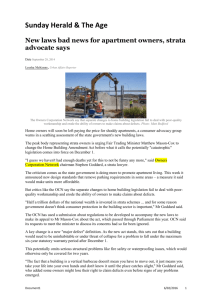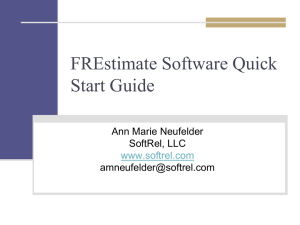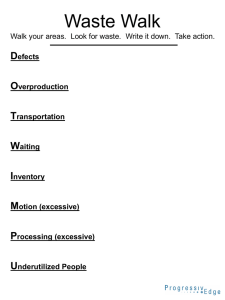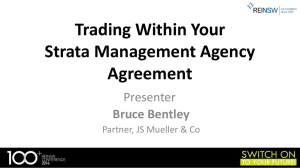Defects-HOW-Strata-presentation_Dec-2012
advertisement
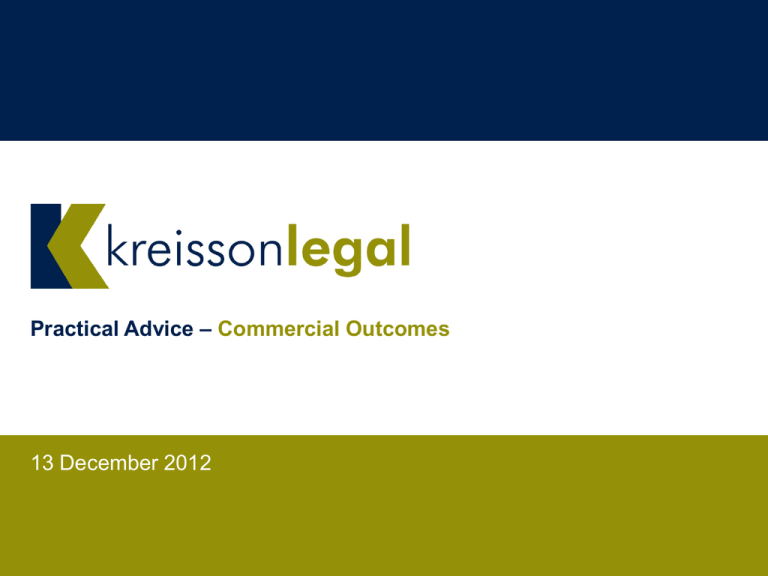
Practical Advice – Commercial Outcomes 13 December 2012 Defects, HOW and Strata 1 Introduction 2 Understanding HOW Insurance 3 Defects and the Home Building Act 1989 4 Legal Advice and Services 2 Defects, HOW and Strata 1 Introduction 2 Understanding HOW Insurance 3 Defects and the Home Building Act 1989 4 Legal Advice and Services 3 Recent Changes to the Home Building Act 1989 (HBA) 1. Changes to the HBA were introduced in October 2011 2. Application of Amendments 3. Some important exceptions 4. Some key areas identified by the Issues Paper for potential reform 5. Some of the issues under consideration in the Discussion Paper include: • Whether a maintenance schedule should be prepared by the developer • Whether defects should be a compulsory agenda item at the first AGM • Whether the law should set clear rules for voting on action regarding defects • Whether there should be any other changes made to the strata laws to more adequately deal with defects 4 Defects, HOW and Strata 1 Introduction 2 Understanding HOW Insurance 3 Defects and the Home Building Act 1989 4 Legal Advice and Services 5 Understanding HOW Insurance Since the HBA began on 1 May 1997 there have been 4 significant changes to the private insurance scheme, the latest as recently as 1 April 2009: HOW Insurance Mark I HOW Insurance Mark II – “Last Resort” • • • • Applies to residential building work commenced in the period from 1 May 1997 to 30 June 2002. “First resort insurance”. Owners corporation can make a claim directly to insurer without taking other action against Builder or developer. • • • • • • • Applies to residential building work commenced in the period from 1 July 2002 to date. Known as the “last resort scheme”. Owners Corporation must exhaust all avenues against the Builder. Owners Corporation becomes entitled to make a HOW claim when the builder dies, disappears or becomes insolvent. Makes a distinction between “structural defects” and other defects. Different time limits apply for making of claims by Owners corporations. New amendments introduced in s103BA. Claims to insurers are easily overlooked because of the complaints process under the HBA and “the last resort insurance” scheme. 6 Understanding HOW Insurance Since the HBA began on 1 May 1997 there have been 4 significant changes to the private insurance scheme, the latest as recently as 1 April 2009: HOW Insurance Mark III HOW Insurance Mark IV • • • • With effect from 31 December 2003, clause 74 of the Home Building Regulation 2004 grants an exemption for the requirement for a builder to comply with Part 6 of the HBA. Exemption applies to construction of multi storey building which means: – a rise of more than 3 storeys – that contains 2 or more separate dwellings. All other aspects of HOW II remain effective. • • • • Applies to a contracts of insurance entered into after 19 May 2009. Last resort insurance scheme. New insurance trigger inserted into the HBA that Builders license has been suspended because of failure to comply with CTTT or Court order. Amendment extends definition of insolvency to deem suspension of contractor’s licence. Other aspects of Mark II and III apply. 7 Completion date • When are the Works completed? • What does completion of Residential Building works mean? 8 Main documents to be lodged for Claim The insurers claim form lists the documents to be lodged. The main documents consist of the following: a) The building contract b) Builders certificates of HOW insurance c) Value of the building works and details of progress payments d) An accurate description of the defective or incomplete works. Unless the list of defects is short the Owners Corporation should obtain a report from a building consultant which sets out: • All the defects • Cause of the defect • The relevant provision of the Building Code or legislation which the been breach in the case of each defect • Scope of works for rectification of each defect • An estimated rectification cost • Any experts reports or photos 9 Defects, HOW and Strata 1 Introduction 2 Understanding HOW Insurance 3 Defects and the Home Building Act 1989 4 Legal Advice and Services 10 What is a defect? 1. The Owners Corporation has a mandatory duty to maintain the common property and repair any common property defects: s62 of the Strata Schemes Management Act 1996. This duty applies to the Owners Corporation even where the developer or builder is at fault. 2. The Oxford English Dictionary speaks of a defect in terms of “falling short” a blemish, flaw or imperfection. The Building Code of Australia says that a defect is any faulty workmanship which does not strictly complying with the requirements of the agreement. 3. One court said that that the word “defective” simply means workmanship, design or material, which is ineffective for the purposes for which it was intended. 4. Whether a complaint of a defect by an owner is in fact a defect is therefore not always easy to determine and will often require a judgement call most often based upon technical building expertise and building standards. 11 What is a defect? 5. To assist in identifying defects the Department of Fair Trading has published a Guide to Standards and Tolerances. 6. When is a defect a defect? • Is it a defect when rectification work is actually carried out? • Or is a defect a defect only when a builder fails to rectify it during construction or at all? 7. If it is established that a defect does exist what is a builders obligation to rectify the defect under the contract? 8. Must the Owners Corporation rectify the defect at all costs? 9. Due to the complex nature of defining a defect, Owners Corporations should consult technical experts early. 12 Essential elements of a defect claim A building defect claim requires proof of the following: • Liability • Damages Liability Liability against a builder, developer or other party must be proven in order for a claim to succeed. Liability is generally established by reference to: • the statutory warranties in the HBA • the specific requirements of the building contract including plans and specifications • the requirements of the certifying authority • the Building Code of Australia • the relevant Australian standards • “Good Building Practice” 13 Statutory Warranties 1. Section 18B of the Home Building Act 1989 defines which warranties are implied in every contract to do residential building work. 2. The warranties or promises are ambiguous in their language. For example “proper and workmanlike” (section 18B(a) and “good and suitable” (section 18B(b)). 3. The ambiguity is there deliberately so that the court can consider on a case by case basis if a builder has not complied with the warranties. These warranties apply to: 4. • The owner of the land for whom the works were performed [section 18B] • The immediate successor in title to the first owner [the second owner] except to the extent that the first owner enforced a statutory warranty [s18C] • Any later successors in title after the second owner except to the extent that the earlier successor in title enforce a statutory warranty [section 18C] As successors in title, Owners Corporations and lot owners have the benefit of these warranties. 14 Remedies 1. Damages 2. Orders that work be performed s48O of the Home Building Act 1989 15 Defects, HOW and Strata 1 Introduction 2 Understanding HOW Insurance 3 Defects and the Home Building Act 1989 4 Legal Advice and Services 16 Procedure to engage lawyers As from 7 February 2005, an owners corporation wishing to seek legal advice, obtain legal services or begin legal action must follow certain steps before a lawyer can be engaged. These steps are set out in ss80D and 230A of the Strata Schemes Management Act 1996 and Regulation 15 of the Strata Scheme Management Regulations. Step Description 1 Obtain written costs estimate for Lawyer pursuant to the Legal Profession Act 2004 (NSW) 2 Owners Corporation to serve the disclosure statement and costs agreement from lawyer to each lot owner and Executive Committee member 3 Resolution must be passed before the Owners Corporation can engage the lawyer or sign the costs agreement. 4 Resolutions can be passed as follows: (a) Executive committee – if estimate does not exceed $12,500 or the sum of $1,000 multiplied by the number of lots whichever is the lower (b) General meeting if the lawyers costs are above the threshold (c) Strata Manager provided agent has delegated authority in agency agreement ss 28 and 29(1) 5 Copy of the Resolution to be given to the lawyer 17 Tips for Strata Managers on how to Manage a Defect Claim Below is a summary [not exhaustive] of steps that should be taken in managing a defect claim: Step Description 1 Establish the Date of Completion of the Works. 2 Identify the Home Owners Warranty Insurer. 3 Develop a process to identify defects early and well before the expiration of 2 year non substantial defects period. 4 Engage consultant to identify defects. Consultant should be properly briefed and scope of report properly defined. 5 Obtain legal advice early. 6 Notify Builder and Developer as soon as defects are identified. 7 Establish critical completion date for rectification of defects. 8 Commence proceedings if defects are not rectified. Ensure that proceedings are commenced with prescribed time frames. 9 Ensure that notification and claim to HOW insurer is made within the prescribed times. 18 Kreisson Legal David Glinatsis Solicitor Director (02) 8239 6502 david.glinatsis@kreissonlegal.com.au Helen Amanatiadis Senior Associate (02) 8239 6508 helen.amanatiadis@kreissonlegal.com.au Kreisson Legal Level 30, 201 Elisabeth St, Sydney NSW 2000 P: (02) 8239 6500 | F: (02) 8239 6501 www.kreissonlegal.com.au 19
